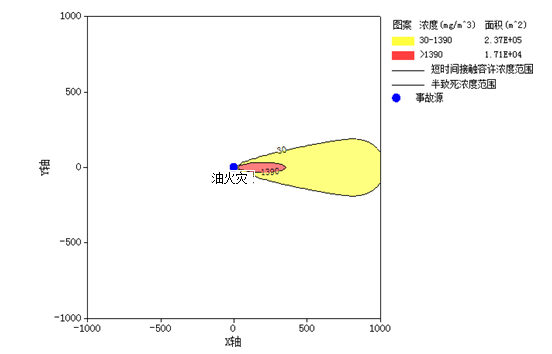All categories
20
2019
-
11
Emergency Response Plan for Sudden Environmental Incidents of Chongqing Hejia Machinery Parts Manufacturing Co., Ltd. (2)
Author:
To prevent unrelated personnel from entering the scene and causing harm,
7.7.2 Definition and method of the accident scene isolation zone:
To prevent unrelated personnel from entering the scene and causing harm, establish a warning area according to the danger zone settings, and define the scope of the accident scene isolation zone:
(1) The boundaries of the warning area should have warning signs and be monitored by designated personnel;
(2) Except for firefighters, emergency responders, and essential personnel who must remain on duty, other personnel are prohibited from entering the warning area;
(3) Pay attention to the wind direction in the accident area, especially the surrounding environment downwind, and implement temporary martial law measures on roads outside the accident area;
(4) No open flames are allowed in the martial law area; quickly control potential ignition sources in the direction of leakage spread, and restrict vehicle or pedestrian access;
(5) Fires caused by leaks may affect nearby units; contact them as soon as possible to explain the situation and request them to take safety measures;
(6) Hazardous substances that leak may spread and cause larger area fires; contact relevant government agencies as soon as possible to explain the situation and request assistance.
7.7.3 Methods for isolating roads or directing traffic around the accident scene:
(1) The road diversion in the central accident area is managed by factory security, with signs stating 'Accident handling, no entry' set up at intersections of the warning area. Designated personnel should guide detour directions.
(2) Roads outside the affected area of the accident are managed by government traffic management departments, prohibiting any vehicles and personnel from entering, and responsible for indicating detour directions.
7.7.4 Rescue and relief
(1) Rescue principles
① In case of casualties, rescue and first aid work must be urgent, timely, decisive, and correct; delays are not allowed;
② Rescue personnel entering dangerous areas must operate in groups of two or more;
③ Rescue personnel must ensure their own safety while providing assistance;
④ Rescue personnel must follow commands, understand the characteristics of hazardous materials and site conditions, and wear complete protective gear;
⑤ Quickly carry injured persons away from the scene using correct methods;
(2) Personnel protection
① Respiratory protection: When there is a possibility of exposure to vapors, gas masks or air-supplying helmets must be worn;
② Eye protection: Wear chemical safety goggles;
③ Protective clothing: Wear work clothes (made of corrosion-resistant materials);
④ Hand protection: Wear rubber gloves;
Rescue and relief personnel must dress according to regulations, wear personal protective equipment properly, pay attention to wind direction, and during rainy weather or nighttime rescues, should be equipped with lighting devices.
(3) Personnel monitoring
Rescue and relief personnel primarily rely on mutual monitoring while ensuring their own safety during rescue operations. If unforeseen factors lead to injuries among team members during rescue operations, other rescuers must report to command headquarters upon discovery and decide whether to provide support. If support is requested, command headquarters will issue orders for a standby rescue team to enter the accident scene for assistance while also evacuating injured personnel from dangerous areas.
7.8 Safety protection and disaster prevention
7.8.1 Safety protection
(1) Safety protection for emergency personnel
Personnel responsible for rescue and first aid should immediately bring rescue and protective equipment to the scene after receiving notification from the command group, waiting for instructions and following commands. The team leader will assign tasks in batches to enter the incident point for rescue or aid. Before entering the accident site, the team leader must report the number of participating rescue personnel and their names to the overall commander.
After completing their tasks, team leaders report back to the overall commander on task execution status and safety conditions of rescue or aid personnel, requesting evacuation orders. The overall commander will make immediate decisions on whether to evacuate or continue rescue operations based on accident control conditions. If an evacuation order is received by a team leader, they will lead rescue or aid personnel away from the accident site to a safe location, count personnel, and report back to the overall commander.
(2) Safety protection for affected populations
When an accident threatens sensitive points nearby, command groups will notify local governments, surrounding units, or residents via phone or by sending personnel. In severe emergencies, surrounding individuals will be informed via phone for timely evacuation while directly contacting government officials or nearby unit leaders through command headquarters. The overall commander will personally inform government officials or leaders about the situation, requesting organization for evacuation or assistance. When issuing messages, it is essential to communicate the urgency of the situation clearly along with specific methods for evacuation including precautions, considerations, evacuation directions, and distances. Evacuations should generally follow planned routes in an organized manner.
7.8.2 Prevention of secondary disasters
When lubricants encounter open flames or high temperatures causing fire accidents, combustion products such as CO, CO2, smoke dust, and unburned hydrocarbons may diffuse into the external environment without significantly affecting atmospheric conditions.
The firefighting process may produce large amounts of solid waste such as dry powder, sand soil, and oily substances. If these are discarded or discharged carelessly after an incident, it can lead to secondary pollution. Water pollution incidents are most likely when oil products enter Ganzi Creek affecting its water quality.
7.9 Emergency status termination
'Level I' emergency termination for sudden environmental events is announced by Jiangjin District government departments; 'Level II' emergency termination is reported by Hejia Machinery Company within its factory area.
(1) 'Ganzi Creek water quality pollution incident' emergency termination conditions: The conditions that triggered sudden environmental events affecting Ganzi Creek water quality have been eliminated; pollution sources have been controlled; pollutants in the river have been reduced to within specified limits; environmental hazards caused have been largely eliminated; response should be terminated.
(2) Conditions for emergencyof other environmental pollution incidents: If the danger is eliminated or effectively controlled, the emergency commander should appoint a special person to inform the neighboring residents and units that were notified at the time of the incident about the danger being lifted.
7.10 Information Release
When Hanjia Machinery Company experiences a Level I incident, information should be released promptly.
7.10.1 Principles of Information Release
According to the principles of 'timely and proactive, accurate grasp, correct guidance, attention to methods, focus on effects, compliance with discipline, and strict control', the emergency commander or deputy commander should promptly and accurately inform the media about the incident.
7.10.2 Content of Information Release
(1) Time and place of the sudden event.
(2) Overview of the accident facility.
(3) Rescue situation, including measures taken, progress made, and measures to be taken.
(4) Medical and placement situation of rescued individuals.
(5) Aftermath handling situation.
(6) Other issues of public concern.
7.10.3 Methods of Information Release
Information release can adopt one or several of the following methods:
(1) Utilize media such as television, radio, newspapers, and magazines, inviting reporters for on-site coverage.
(2) Open a hotline and set up a dedicated reception room to answer public concerns at any time.
8 Aftermath Handling
After a sudden environmental incident occurs, no unit or individual may arbitrarily destroy the accident scene. All equipment and facilities at the accident scene must be protected for investigation and analysis of the cause. The alert evacuation team should quickly seal off all road entrances to the scene. In case of an explosion-type accident, seal off along the radius of the explosion's aftermath; for other accidents, seal off along the accident site and contaminated area. The accident investigation team should take video and photos for evidence analysis and conduct an accident investigation. Other unrelated personnel are prohibited from entering to ensure smooth progress in accident investigation work and timely summarize emergency rescue work in writing for record-keeping.
8.2 Accident Pollutant Treatment
Pollutants generated due to accidents should be treated based on the principle of scientific handling to minimize pollution to the surrounding environment.
For wastewater generated during accident handling, direct discharge into sewers is prohibited. An accident water collection system should be used to transport it to sewage treatment facilities for batch processing.
Firefighting sand containing hazardous waste generated during accident handling, as well as unusable hazardous waste, should be collected in hazardous waste storage sites and entrusted to qualified treatment units for disposal.
8.3 Ecological Restoration
If Hanjia Machinery Company experiences a sudden environmental incident that mainly affects the water quality of Ganzi Creek, active purification measures should be taken after the incident occurs, monitoring the water quality of Ganzi Creek until it stabilizes and meets standards.
If there is a pipeline leak along the route, severely contaminated soil should be repaired promptly.
8.4 Rewards
Departments and individuals with one of the following achievements in emergency rescue work during sudden environmental incidents should be rewarded according to relevant regulations:
(1) Outstandingly completing emergency response tasks for sudden environmental incidents with significant achievements;
(2) Contributing to preventing or saving from sudden environmental incidents, protecting national interests, company assets, and people's lives from loss or reducing damage;
(3) Proposing significant suggestions for emergency preparedness and response with notable implementation effects;
(4) Having other special contributions.
8.5 Accountability
In emergency work related to sudden environmental incidents, those who engage in any of the following behaviors will be dealt with by their respective departments according to relevant laws and regulations based on circumstances and harmful consequences; if a crime is constituted, criminal responsibility will be pursued by judicial authorities according to law:
(1) Failing to seriously implement environmental protection laws and regulations that lead to environmental incidents;
(2) Not formulating emergency plans for sudden environmental incidents as required and refusing to undertake emergency preparedness obligations;
的;
(3) Not reporting or notifying the true situation of sudden environmental incidents as required;
(4) Refusing to execute emergency plans for sudden environmental incidents, disobeying orders and commands, or fleeing during emergency response;
(5) Theft, embezzlement, or misappropriation of funds, equipment, and materials related to emergency work for environmental incidents;
(6) Obstructing emergency personnel from carrying out their duties or engaging in destructive activities in accordance with the law in environmental incidents;
(7) Spreading rumors and disrupting social order;
(8) Other behaviors that may cause harm to environmental emergency response work.
(7) Spreading rumors and disrupting social order;
(8) Other behaviors that may cause harm to environmental emergency response work.
8.6 (9)
(10)
8.7 (12)
(1) (14)
(16)
(2) (18)
(20)
9.1 Communication Guarantee
9 Emergency Guarantee
Hejia Machinery Company's emergency communication system mainly relies on the office landline (023-47607886). The Materials Department of Hejia Machinery Company is responsible for the maintenance of daily emergency communication equipment, ensuring the smooth operation of telephone, telecommunications, and network lines and equipment during emergencies. They will contact the telecommunications department to establish temporary lines as needed and impose communication line control if necessary.
9.2 Technical Guarantee
During the emergency response status, request relevant departments such as the Jiangjin District Environmental Protection Bureau, Meteorological Bureau, and Health Bureau to provide necessary environmental monitoring, wind speed and direction, medical assistance data, and technical support for emergency rescue decision-making and response actions. Additionally, rely on experts from Chongqing's environmental emergency expert database to ensure that relevant environmental experts can quickly arrive before the warning is activated and after the incident occurs to provide services for command decision-making.
The experts for environmental emergency rescue in Chongqing City are shown in Attachment 3.
9.3 Fire Safety Guarantee
Hejia Machinery Company's duty personnel organize regular inspections, maintenance, and updates of fire safety measures. The existing fire safety facilities mainly include protective facilities, safety signs, emergency handling facilities, firefighting facilities, escape facilities, and labor protection supplies.
9.4 Financial Guarantee
The company's finance department is responsible for establishing and managing special funds for emergency guarantees to ensure timely funding for the procurement and maintenance of various emergency materials and facilities. Clearly define the sources of special emergency funds, their usage scope, amounts, and supervision management measures to ensure timely availability of emergency funds during emergencies.
9.5 Transportation Guarantee
During emergency responses, fully utilize company vehicles to ensure timely transportation of emergency rescue personnel, equipment, and materials. In case of an accident, call existing transportation resources in Jiangjin District such as 119 or 120 for support.
9.6 Medical Health Guarantee
After a sudden environmental accident occurs, request relevant medical institutions in Jiangjin District to provide medical health guarantees. The nearest major hospital is Jiangjin District Third People's Hospital, which is about 5 kilometers from the company and can reach the accident site within 10 minutes after an incident occurs.
9.7 Emergency Power Supply and Lighting
Emergency power supply mainly relies on the emergency power supply vehicle from the power bureau and other emergency power sources.
9.8 Emergency Rescue Materials
(1) Emergency Material Statistics
To ensure timely and effective rescue work during company safety accidents, Hejia Machinery Company has established an emergency rescue equipment guarantee system to provide comprehensive support for rescue operations. Emergency rescue materials are managed by the Materials Management Department, which is responsible for distributing them during sudden events. The overall commander or deputy commander regularly inspects emergency rescue materials to ensure they are delivered promptly to the rescue site when an accident occurs. The current statistics of Hejia Machinery Company's emergency materials are shown in the table below.

Hejia Machinery Company needs to strengthen the maintenance of emergency materials regularly so that they can be better utilized during sudden events to minimize accident losses. In case of external-level sudden environmental events, we mainly rely on local government departments' emergency rescue materials and teams. The company's emergency materials are managed by a warehouse manager (contact number: 15923290110).
(2) Emergency Material Management
Establish an 'Emergency Material Management System' adhering to the principles of 'division of responsibilities' and 'whoever is in charge is responsible,' ensuring 'professional management, urgent needs guarantee, dedicated use.'
--- According to the requirements of the 'Emergency Material Management System,' strengthen the custody, maintenance, replenishment, updating, deployment, return, reception of emergency materials to ensure they do not deteriorate or become unusable.
--- Each department must report on the reserve and usage status of emergency materials regularly according to the information reporting system, with reports submitted once a month.
--- For deploying emergency materials, each department implements a 'leader responsibility system' for autonomous mobilization; only with authorization from material management personnel can they coordinate the allocation of emergency materials.
--- Strengthen supervision and inspection over procurement, storage, management processes of emergency materials; serious consequences will be imposed for issues like chaotic management or misappropriation.
9.9 Emergency Rescue Team Guarantee
9.9.1 Internal Emergency Team Guarantee
Based on coordinated planning and reasonable deployment principles, gradually establish and improve an emergency team system. Strengthen business training and drills for emergency teams; integrate existing resources; utilize coordination mechanisms to enhance equipment levels. Hejia Machinery Company has organized an emergency rescue team including a rescue repair group, alert evacuation group, logistics support group, and aftermath handling group. The company should continuously strengthen business training and drills for its emergency rescue team to improve their quality so that they can quickly engage in rescue work during sudden environmental events. If personnel are reassigned, timely replacements should be made. The current internal emergency rescue team mainly handles team-level and company-level sudden environmental pollution incidents; in external-level incidents, we primarily rely on local government rescue teams.
Hejia Machinery Company's internal emergency contact list is shown in Attachment 1.
9.9.2 External Rescue Teams
In case of a Level I sudden environmental pollution incident requiring external support, relevant emergency units in Jiangjin District can quickly arrive at the scene for rescue operations. Contact information for external rescue organizations, government departments, and surrounding units is provided in Attachment 2.
When an incident escalates requiring government assistance for rescue efforts from relevant departments such as Jiangjin District Government, Jiangjin District Environmental Protection Bureau, Jiangjin District Safety Supervision Bureau, Fire Department etc., a support order can be issued to mobilize relevant government departments for full support and assistance.
9.10 Preventive Measures
(1) Arrange duty personnel to report any abnormal situations occurring within all production areas in a timely manner.
(2) Enhance training on publicity; regularly educate on environmental protection knowledge, fire safety knowledge, safety awareness among onsite workers to improve their skills in environmental protection awareness and handling sudden incidents; conduct regular drills based on plans.
(3) 'Safety Month' during major holidays will be overseen by Hejia Machinery Company leadership responsible for safety inspections; personnel from the Materials Department will conduct fire safety checks at least once a week.
(4) 'Transport pipelines should be regularly inspected to promptly identify damages or leaks; strategies must be in place for any decline in pipeline performance; valves must be replaced immediately if blocked or leaking.
(5) All staff should be proficient in wearing protective equipment and using fire extinguishing equipment and other devices; fire safety equipment should be fully equipped; all staff should take care of and protect fire safety facilities and equipment, and promptly rectify and repair any issues found.
(6) If a hazard is discovered during the production process, decisive measures should be taken promptly to handle the situation according to the hazard, call the emergency command phone, report the situation in a timely manner, and organize personnel for rescue.
(7) Strictly implement various rules and regulations to eliminate all potential hazards and accidents.
10.1 Emergency plan filing
10 Plan management
According to the requirements of the Jiangjin District Environmental Protection Bureau, this plan should be filed on the Chongqing Emergency Environmental Incident Risk Assessment and Emergency Plan Filing Platform, and a paper document should also be submitted to the Jiangjin District Environmental Protection Bureau for filing.
10.2 Maintenance and updates
The emergency office organizes the drafting, with relevant departments participating in review and discussion. After approval by the emergency commander, it will be released for implementation. A copy will also be sent to relevant government departments, surrounding enterprises, and communities.
This plan should be reviewed internally at least once a year, and revisions should be organized promptly based on the review conclusions. The plan should be revised promptly and sent to relevant departments of the company for study when the following situations occur:
(1) There are significant adjustments in the members of the emergency rescue team.
(2) There are significant adjustments in emergency resources on-site or losses due to natural disasters.
(3) Significant defects or problems are found during production activities, emergency rescue, and drills.
(4) Other significant changes and adjustments closely related to the emergency plan.
10.3 Formulation and interpretation
Department responsible for revising and interpreting the emergency plan: Emergency Office of Chongqing Hejia Machinery Parts Manufacturing Co., Ltd.
10.4 Implementation of the emergency plan
This plan takes effect from the date it is approved and released by the company's legal representative.
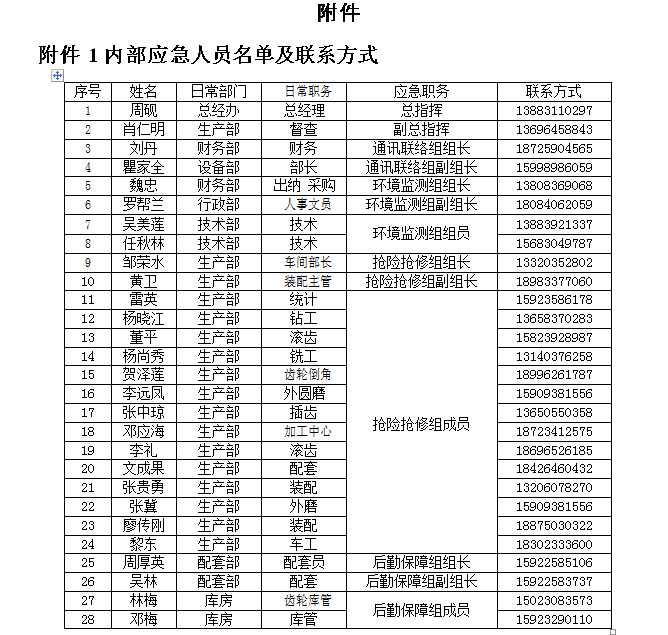


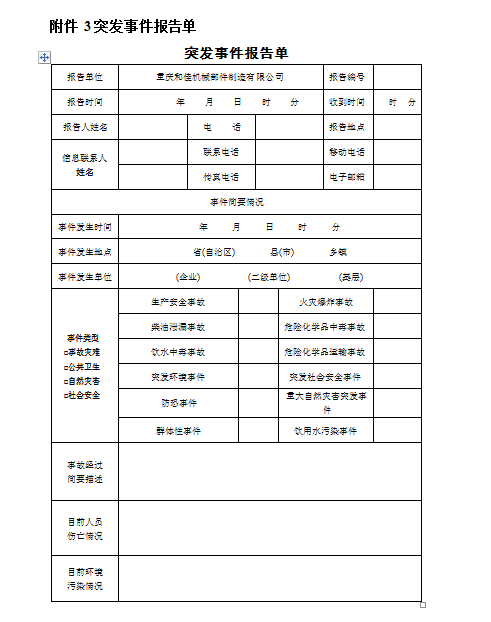
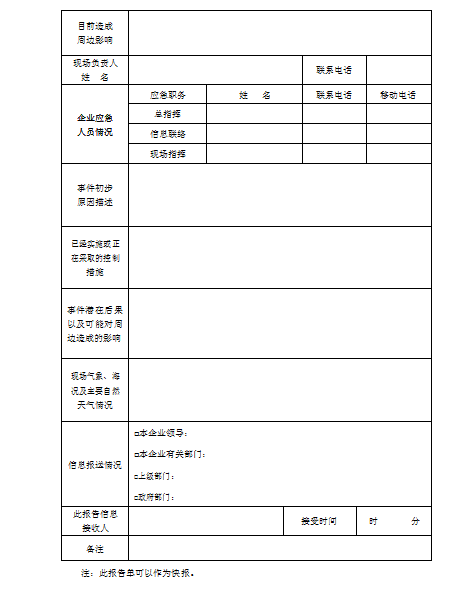
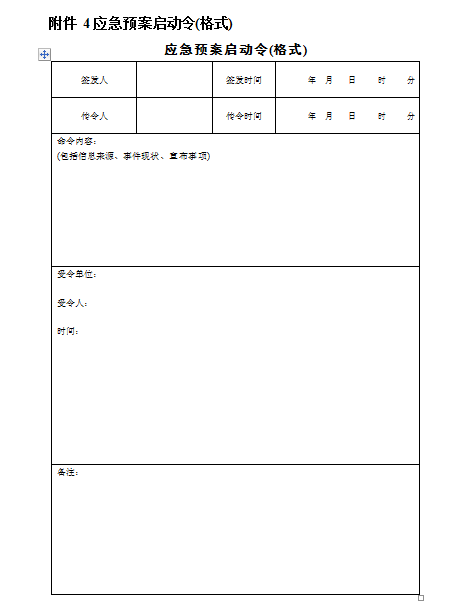
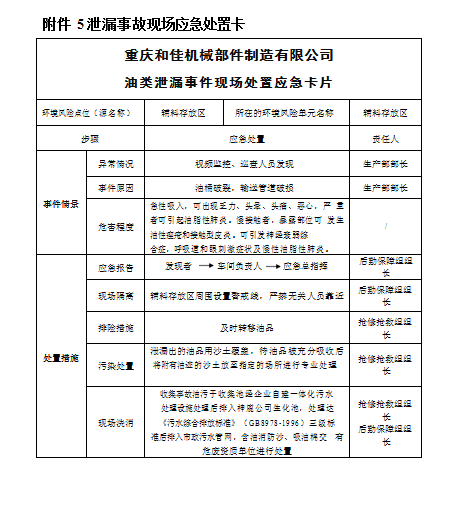
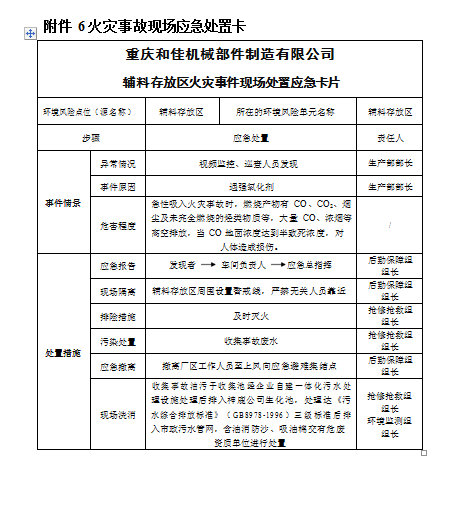
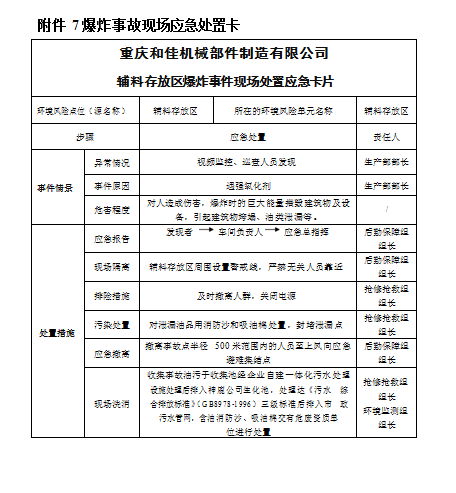
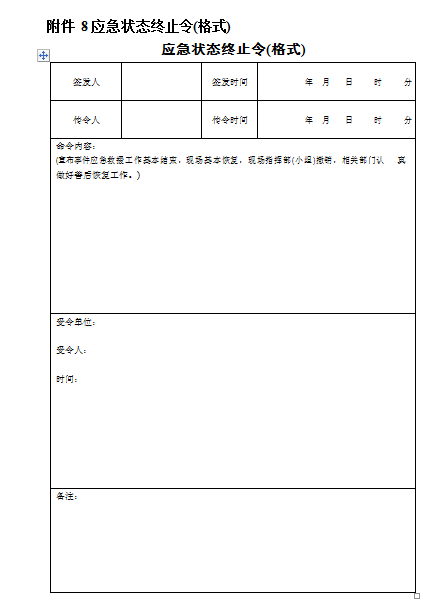
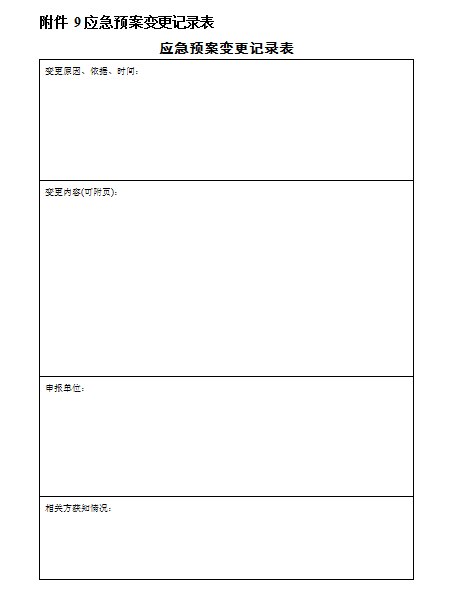
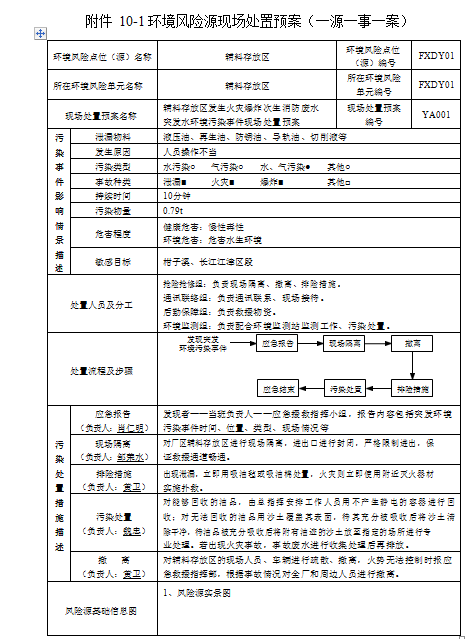
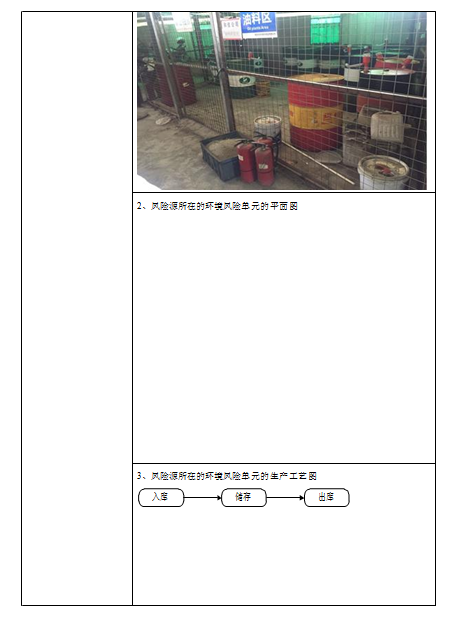
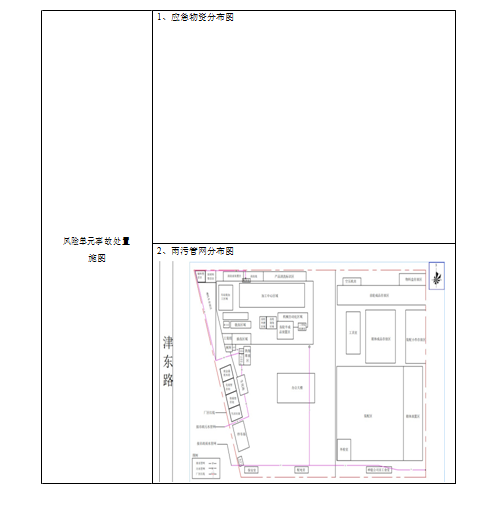
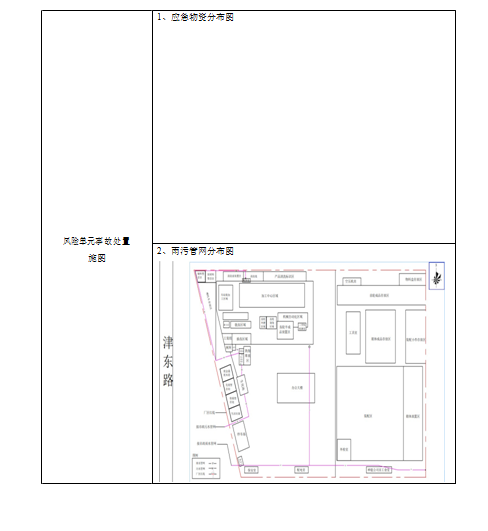
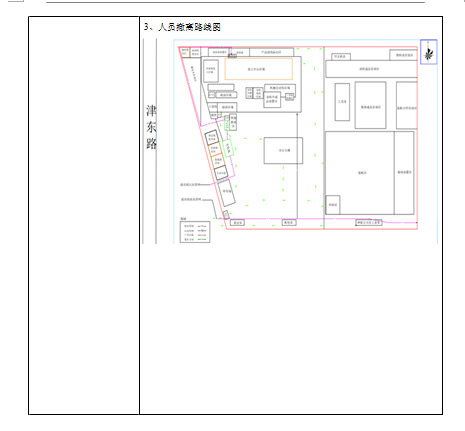
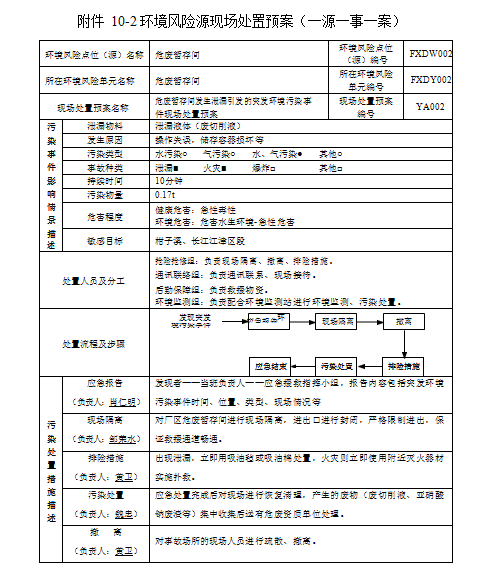
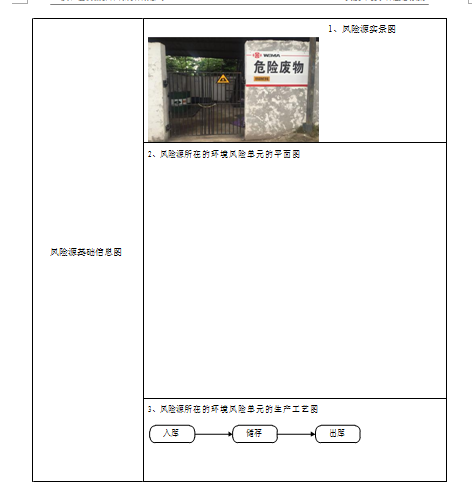
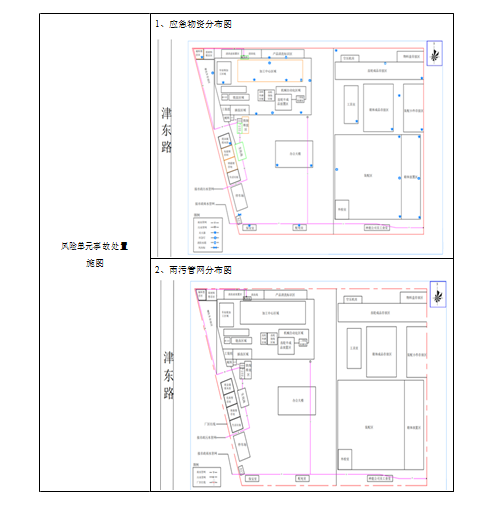
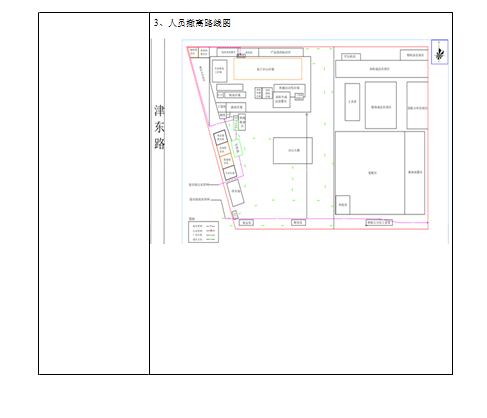
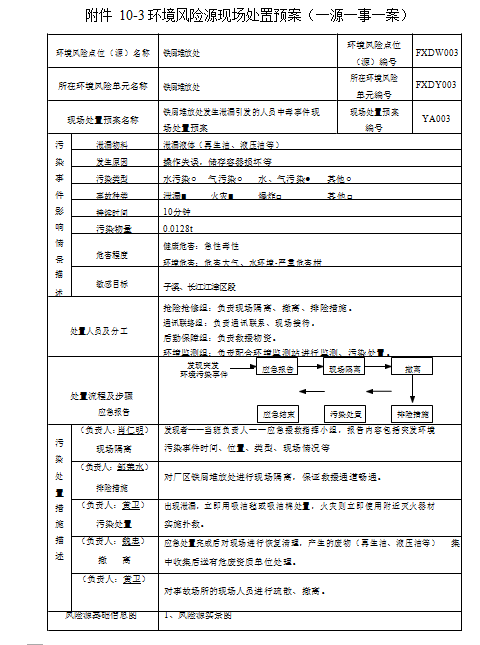
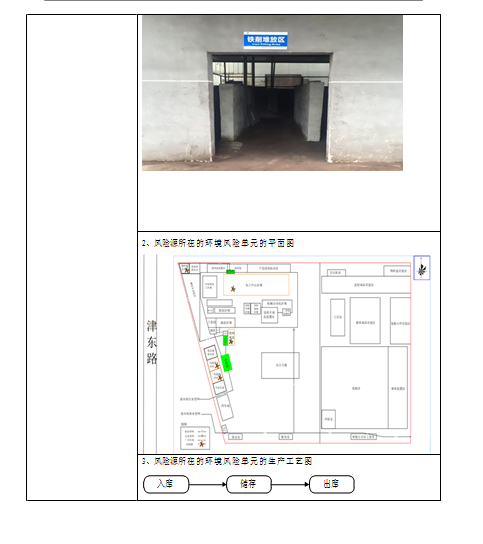
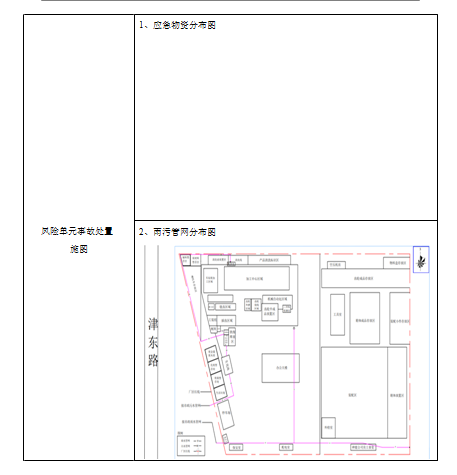
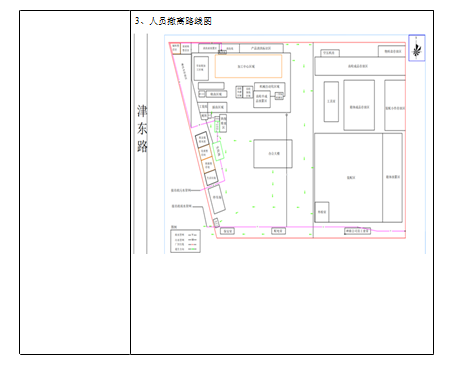
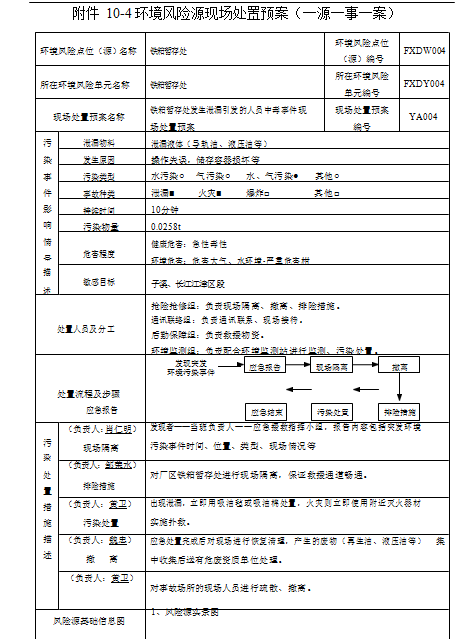
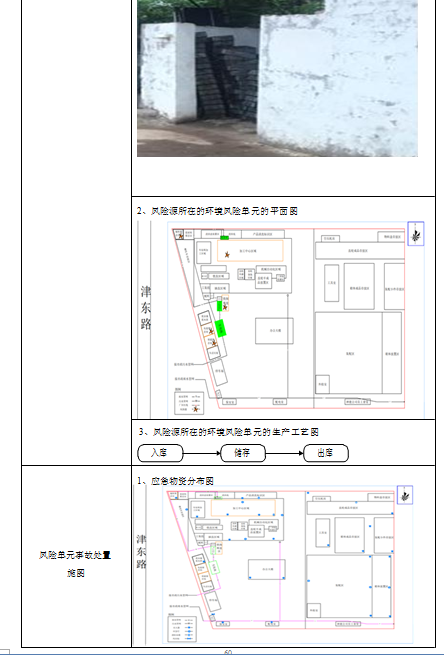
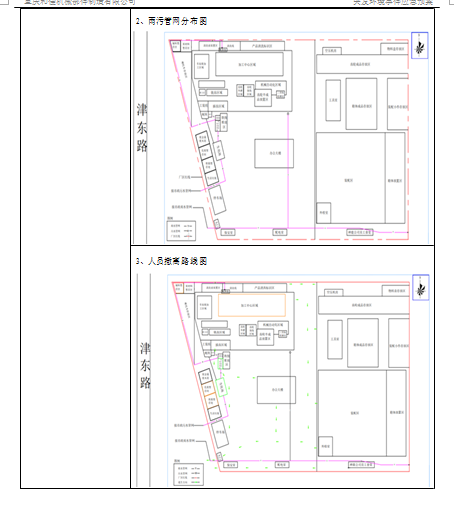
3.4.2 Diffusion Pathways of Risk Substances in Water Environment Under abnormal circumstances
2019-11-20
There are risks of leakage and fire during the transportation of raw materials such as guide rail oil
2019-11-20



